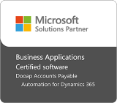Insights from an Industry Expert on Achieving AP Excellence.
As the year nears to a close, we had an opportunity to catch up with Robert Cohen, Research Director for research and advisory firm Ardent Partners, to discuss industry trends and insights from the firm’s recent State of ePayables 2018 report.
The report provides a comprehensive view into the AP marketplace today, including current levels of automation, best-in-class practices and benchmarks, and recommendations for performance improvement. It also sheds light on the future of AP and where forward-thinking companies should be heading.
Here are some highlights from our discussion:
Dooap: What are some of the key challenges Accounts Payable departments are facing now?
Bob: As you know, AP has been one of the last areas of an organization to be automated. While the industry as a whole is moving toward automation, there are still many companies that are bogged down with manual processes and drowning in paper. For those that are embracing automation, however, the challenge is to reduce the number of exceptions that they are handling. Our report found that AP professionals spend about 24 percent of their time handling exceptions, such as fixing invoices and dealing with payment errors. That is too much time being spent on tactical activities, and it takes away from the time that could be better spent on strategic activities.
But within every challenge is also an opportunity. As AP departments embrace and increase their levels of automation, they can address these challenges, as well as benefit from increased efficiencies and cost reductions and provide added value to their organizations.
Dooap: Where is the market in terms of technology adoption?
Bob: While the level of technology maturity varies from company to company, in general, many smaller companies have outgrown their manual processes and are trying to figure out how to automate to gain efficiencies, cut down on paper and manual processes, and improve visibility. Typically, many larger companies are further along on the path to automation, mostly out of necessity. It simply has been too hard for them to keep up with the large volume of invoices and they haven’t been able to solve that by adding more staff. While many of these companies have begun the automation process, they still have areas to improve: as mentioned above, they are handling too many exceptions and are not leveraging their invoice data to drive better spend, supplier or cash management decisions.
Dooap: How is AP perceived within the larger organization?
Bob: The good news is that we’re seeing progress. In our State of ePayables 2018 report, 52 percent of organizations perceived AP to be very or exceptionally valuable to their operations – an increase of 19 percent from just two years prior. However, we still have a lot of work to do in this area. AP has made strides in providing efficiencies and reducing manual processes, but it still needs to demonstrate greater value to the organization. For example, invoice data provides visibility into outstanding liabilities that can help Treasury improve cash management, information on suppliers that can help Procurement pursue discounts and negotiate better terms, and data on payments that can help Finance develop strategic payment plans and better payment schedules.
As AP provides this type of value and helps to reduce risk by flagging potential fraud, its perception in the greater organization will continue to increase.
Dooap: What are the trends you are seeing in the new year?
Bob: Change in AP has been evolutionary, not revolutionary. We expect to see slow but steady improvement in the adoption of technology, improved efficiencies and reduced manual processes. Specifically, we anticipate an increase in e-invoicing adoption to reduce the amount of paper entering the organization, and more focus on the payment side of purchase-to-pay as organizations look for more payment options.
Looking further out, robotic process automation (RPA) and machine learning will play a role over the next several years as they become embedded in technology to increase automation levels and reduce exceptions.
Dooap: What advice would you give to AP organizations today?
Bob: Continue to look for ways to improve processes and your value to the overall organization. Use technology to unlock the valuable data in your invoices, and depending where your company is in the process, begin the path to automation or work toward continuous improvement. We have seen the critical competitive advantage that best-in-class firms are realizing -- they have significantly lowered exception rates, processing times and cost. And, they are making progress in collaborating with other areas in the organization to become a trusted business partner. These benefits not only help AP departments run more efficiently and effectively, but they also set the stage to elevate the role of AP within the overall organization.
What is AP Automation?
We've gathered everything you need to know about Accounts Payable Automation on one page. If you're ready to learn, just click the button below!








